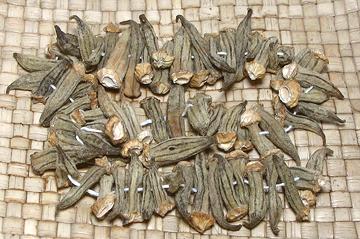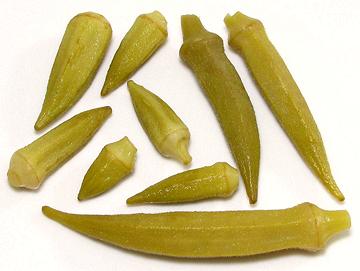 [Bamia (Swahili); Ladies' Fingers, Okro; Okuru (Igbo); Ngombo, Kingombo
(Bantu); Quingombo (Portuguese); Gumbo (US (parts), Caribbean); Endakkai,
Bhindi (India); Bamya (Arab); Abelmoschus esculentus sym.
Hibiscus esculentus]
[Bamia (Swahili); Ladies' Fingers, Okro; Okuru (Igbo); Ngombo, Kingombo
(Bantu); Quingombo (Portuguese); Gumbo (US (parts), Caribbean); Endakkai,
Bhindi (India); Bamya (Arab); Abelmoschus esculentus sym.
Hibiscus esculentus]
The origin of Okra is uncertain, but possibly from Ethiopia or India. The seeds of this mallow were carried to the U.S. with the slave trade. Okra is now grown world wide and is particularly important in the U.S. South, Africa, the Middle East and India.
In African, Middle Eastern and Southern US cooking okra is valued for it's mucilaginousness (sliminess) which adds body to broths and sauces, but in much of the world, India, for example, cooking methods are designed specifically to suppress this characteristic.
Okra Leaves are used in African cooking, but what is sold as "Okra Leaves" in Southern California is a different mallow, Molokhia.
For those who fondly remember eating the seed wheels of Common Mallow as children, the taste can be recaptured in more convenient form by eating Okra pods raw.
More on Mallows.
 This form is popular in Turkey and Armenia for special soups
and stews. Tiny okra pods were traditionally gathered in the summer,
threaded on a string and hung up to dry for use in the winter. The photo
specimens, up to 1-1/8 inches long, were purchased from a multi-ethnic
market in Los Angeles, but they weren't cheap at 2012 US $12.78 / pound
- but they were very light, so you get a lot of them in a half pound
package. I have seen photos of strings of dried okra pods quite a bit
smaller than these.
This form is popular in Turkey and Armenia for special soups
and stews. Tiny okra pods were traditionally gathered in the summer,
threaded on a string and hung up to dry for use in the winter. The photo
specimens, up to 1-1/8 inches long, were purchased from a multi-ethnic
market in Los Angeles, but they weren't cheap at 2012 US $12.78 / pound
- but they were very light, so you get a lot of them in a half pound
package. I have seen photos of strings of dried okra pods quite a bit
smaller than these.
 This form is popular in Turkey and Armenia as part of appetizer
plates. From the evidence of multiple brands in the markets where I shop
it appears the Turks prefer very short okras, naturally pickled,
containing only okra and salt. Thse are very tender, with very good
okra flavor and very low acidity, packed in moderately mucilaginous
liquid (which you can rinse off if you wish). The photo specimens
(to the left in photo) were from 1 inch to 2-1/4 inches long.
This form is popular in Turkey and Armenia as part of appetizer
plates. From the evidence of multiple brands in the markets where I shop
it appears the Turks prefer very short okras, naturally pickled,
containing only okra and salt. Thse are very tender, with very good
okra flavor and very low acidity, packed in moderately mucilaginous
liquid (which you can rinse off if you wish). The photo specimens
(to the left in photo) were from 1 inch to 2-1/4 inches long.
In contrast, the Armenians appear to prefer longer, more mature okra, and may include some acetic acid in the mix, and some herbs. This product was a bit more tart, had a little crunchiness, and had noticeable, but not at all objectional, fiber in the pods. The pods (right and bottom in the photo) ranged up to 4-1/4 inches and 0.57 inch wide.
These specimens were both purchased from a multi-ethnic market in Los Angeles (Sunland) for 2013 US $2.69 / 1-1/2 pound jar (Turkish). I have a slight preferance for the Armenian, but both were enjoyable.
Pickled Okra is also very popular in the American Southeast, often
made at home but also available in jars. These are larger okra than
used in Anatolia and Caucasus and they are pickled in vinegar, with
spices, rather than naturally with salt. The objective here is for them
to be crunchier rather than soft, and with a spicy flavor. Chilis are
often included in the mix.